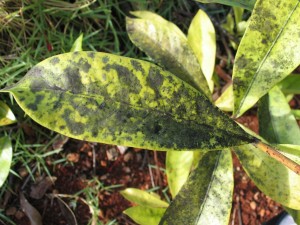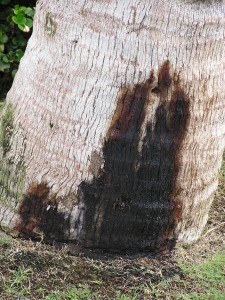Hosts: Any plant that hosts phloem-feeding insects and has honeydew on it Range: Throughout the world’s temperate and tropical regions Symptoms: A black, non-parasitic superficial growth on plant surfaces that can be completely rubbed off with your fingers to reveal healthy plant tissue Spread through: airborne sooty mold spores Control: management is only warranted when …
Category: News
Jun 21
Pest of the Month November 2009 – Coconut Leafroller
Hosts: Coconuts, bananas, native Pritchardias Range: All major Hawaiian Islands. More prevalent in windswept areas, possibly due to wind interference with parasitoids. Believed to be endemic to Hawaii. Symptoms: Young larvae feed on underside of leaves beneath a protective thin web of silk. They leave the opposite epidermis intact. As they get older, they feed …
Jun 21
Pest of the Month October 2009 – Phytophthora cinnamomi
Hosts: Numerous, including koa, ohia,Norfolk pine, Eucalyptus sp., macadamia nut, hala, avocado, and strawberry guava Range: Hawaii, and most of the rest of the world (Africa, Asia, Australia, Europe, North America, South America, Central America, Caribbean, Micronesia, Fiji, New Zealand, Papua New Guinea) Symptoms: primarily root rot in Hawaii plants, leading to dieback and death. …
Jun 21
Pest of the Month August 2009 – Phytophthora Heart Rot
Hosts: Primarily affects coconut palms (Cocos nucifera) Symptoms: Loss of young fruits, brown mottling on immature and mature green fruits, heart rot of plant evident when youngest spear leaf dies, leaf death, death of palm Spread: Via movement of infected nuts and palms, pruning with contaminated equipment, insects, rodents, wind-driven rain Control: Remove and incinerate …
Jun 20
Pest of the Month July 2009 – Cassytha filiformis
Hosts: Mainly woody species including native and naturalized coastal hosts such as tree heliotrope, beach naupaka, ohia lehua, noni, and hala. Habitat: Primarily coastal areas, all major islands except Kaho’olawe. Requires full sun. This species is indigenous toHawaii. Effects: Parasitic. Infections can be fatal to host species. Treatment/prevention: (1) Remove (prune) infected limbs as early …
Jun 20
Pest of the Month June 2009 – Naio Thrips
Hosts: Many species of Myoporum will likely be susceptible. In Hawaii, naio thrips have been observed attacking both the prostrate (naio papa) and upright forms of the indigenous Myoporum sandwicense. Distribution: Northwestern part of the Island of Hawaii. Damage: Severe gall-like distortion of the new leaves and terminals. Stunting of terminal growth and leaf curling …
Jun 20
Pest of the Month May 2009 – Hawaiian Mistletoes
Hosts: Native hardwoods Distribution: Varies by species – see table p. 3 of source document Management: Prune affected branches and destroy them (do not use as mulch). Limit management to high-value forestry or landscape settings since these plants have a useful part in Hawaii‘s ecosystem. Source: Hawaiian Mistletoes (Korthalsella Species), Dr. Scot Nelson and Dr. …
Jun 20
Pest of the Month March 2009 – Red Palm Mite (Pest Alert)
Description: Red Palm Mite (RPM) is a bright red mite with long body hairs, usually with a drop of liquid at the tip of the hair. The body is flat. Range: Native to tropical and subtropical southeast Asia and the Middle East. Expanded range includes Caribbean Islands and Florida. Pathways: Extremely easy to spread. Can …
Jun 20
Pest of the Month February 2009 – Stem Bleeding of Coconut
Cause: Chalara paradoxa, a mainly soilborne plant-pathogenic fungus Hosts: Areca catechu, Barhea edulis, Caryota spp., Cocos nucifera, Elaeis guineensis, Phoenix africanus, Phoenix canariensis, Phoenix dactylifera, Raphis sp., Roystonea elata, Sabal palmetto, Sygarus romanzoffinia, Washingtonia filifera Symptoms: black stain coming from a hole or wound and seeping down the coconut stem Management: Prevention and avoidance – don’t …
Jun 20
Pest of the Month January 2009 – Plumeria Rust
Distribution: Main Hawaiian Islands Host: Plumeria spp. Symptoms: Powdery, yellow-orange lesions on leaves with powdery spore masses on the underside of leaves Management: Plant resistant species or hybrids, leaf litter control/destruction, plant in drier areas, apply approved fungicides when necessary, biological control with fungal hyperparasites and an insect (midge) predator, control weeds to improve airflow, …


